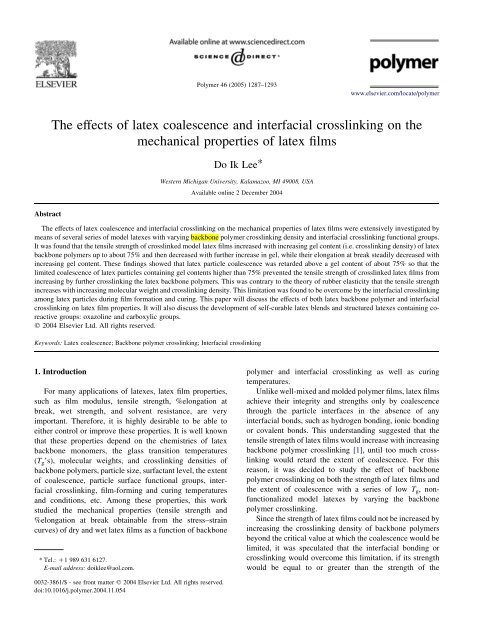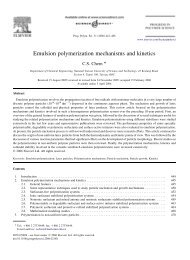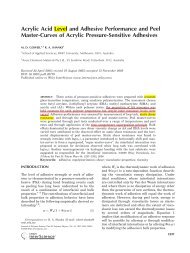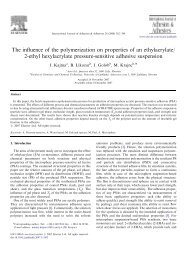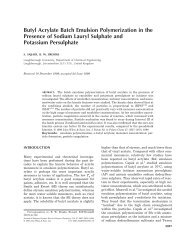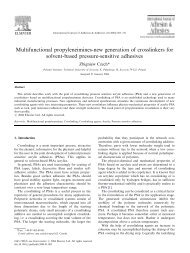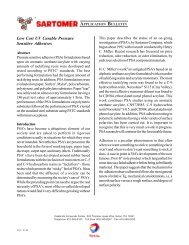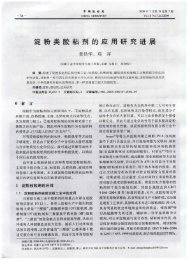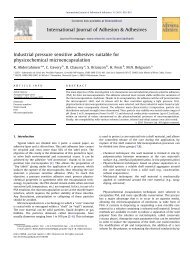The effects of latex coalescence and interfacial crosslinking on the ...
The effects of latex coalescence and interfacial crosslinking on the ...
The effects of latex coalescence and interfacial crosslinking on the ...
Create successful ePaper yourself
Turn your PDF publications into a flip-book with our unique Google optimized e-Paper software.
Polymer 46 (2005) 1287–1293<br />
www.elsevier.com/locate/polymer<br />
<str<strong>on</strong>g>The</str<strong>on</strong>g> <str<strong>on</strong>g>effects</str<strong>on</strong>g> <str<strong>on</strong>g>of</str<strong>on</strong>g> <str<strong>on</strong>g>latex</str<strong>on</strong>g> <str<strong>on</strong>g>coalescence</str<strong>on</strong>g> <str<strong>on</strong>g>and</str<strong>on</strong>g> <str<strong>on</strong>g>interfacial</str<strong>on</strong>g> <str<strong>on</strong>g>crosslinking</str<strong>on</strong>g> <strong>on</strong> <strong>the</strong><br />
mechanical properties <str<strong>on</strong>g>of</str<strong>on</strong>g> <str<strong>on</strong>g>latex</str<strong>on</strong>g> films<br />
Do Ik Lee*<br />
Western Michigan University, Kalamazoo, MI 49008, USA<br />
Available <strong>on</strong>line 2 December 2004<br />
Abstract<br />
<str<strong>on</strong>g>The</str<strong>on</strong>g> <str<strong>on</strong>g>effects</str<strong>on</strong>g> <str<strong>on</strong>g>of</str<strong>on</strong>g> <str<strong>on</strong>g>latex</str<strong>on</strong>g> <str<strong>on</strong>g>coalescence</str<strong>on</strong>g> <str<strong>on</strong>g>and</str<strong>on</strong>g> <str<strong>on</strong>g>interfacial</str<strong>on</strong>g> <str<strong>on</strong>g>crosslinking</str<strong>on</strong>g> <strong>on</strong> <strong>the</strong> mechanical properties <str<strong>on</strong>g>of</str<strong>on</strong>g> <str<strong>on</strong>g>latex</str<strong>on</strong>g> films were extensively investigated by<br />
means <str<strong>on</strong>g>of</str<strong>on</strong>g> several series <str<strong>on</strong>g>of</str<strong>on</strong>g> model <str<strong>on</strong>g>latex</str<strong>on</strong>g>es with varying backb<strong>on</strong>e polymer <str<strong>on</strong>g>crosslinking</str<strong>on</strong>g> density <str<strong>on</strong>g>and</str<strong>on</strong>g> <str<strong>on</strong>g>interfacial</str<strong>on</strong>g> <str<strong>on</strong>g>crosslinking</str<strong>on</strong>g> functi<strong>on</strong>al groups.<br />
It was found that <strong>the</strong> tensile strength <str<strong>on</strong>g>of</str<strong>on</strong>g> crosslinked model <str<strong>on</strong>g>latex</str<strong>on</strong>g> films increased with increasing gel c<strong>on</strong>tent (i.e. <str<strong>on</strong>g>crosslinking</str<strong>on</strong>g> density) <str<strong>on</strong>g>of</str<strong>on</strong>g> <str<strong>on</strong>g>latex</str<strong>on</strong>g><br />
backb<strong>on</strong>e polymers up to about 75% <str<strong>on</strong>g>and</str<strong>on</strong>g> <strong>the</strong>n decreased with fur<strong>the</strong>r increase in gel, while <strong>the</strong>ir el<strong>on</strong>gati<strong>on</strong> at break steadily decreased with<br />
increasing gel c<strong>on</strong>tent. <str<strong>on</strong>g>The</str<strong>on</strong>g>se findings showed that <str<strong>on</strong>g>latex</str<strong>on</strong>g> particle <str<strong>on</strong>g>coalescence</str<strong>on</strong>g> was retarded above a gel c<strong>on</strong>tent <str<strong>on</strong>g>of</str<strong>on</strong>g> about 75% so that <strong>the</strong><br />
limited <str<strong>on</strong>g>coalescence</str<strong>on</strong>g> <str<strong>on</strong>g>of</str<strong>on</strong>g> <str<strong>on</strong>g>latex</str<strong>on</strong>g> particles c<strong>on</strong>taining gel c<strong>on</strong>tents higher than 75% prevented <strong>the</strong> tensile strength <str<strong>on</strong>g>of</str<strong>on</strong>g> crosslinked <str<strong>on</strong>g>latex</str<strong>on</strong>g> films from<br />
increasing by fur<strong>the</strong>r <str<strong>on</strong>g>crosslinking</str<strong>on</strong>g> <strong>the</strong> <str<strong>on</strong>g>latex</str<strong>on</strong>g> backb<strong>on</strong>e polymers. This was c<strong>on</strong>trary to <strong>the</strong> <strong>the</strong>ory <str<strong>on</strong>g>of</str<strong>on</strong>g> rubber elasticity that <strong>the</strong> tensile strength<br />
increases with increasing molecular weight <str<strong>on</strong>g>and</str<strong>on</strong>g> <str<strong>on</strong>g>crosslinking</str<strong>on</strong>g> density. This limitati<strong>on</strong> was found to be overcome by <strong>the</strong> <str<strong>on</strong>g>interfacial</str<strong>on</strong>g> <str<strong>on</strong>g>crosslinking</str<strong>on</strong>g><br />
am<strong>on</strong>g <str<strong>on</strong>g>latex</str<strong>on</strong>g> particles during film formati<strong>on</strong> <str<strong>on</strong>g>and</str<strong>on</strong>g> curing. This paper will discuss <strong>the</strong> <str<strong>on</strong>g>effects</str<strong>on</strong>g> <str<strong>on</strong>g>of</str<strong>on</strong>g> both <str<strong>on</strong>g>latex</str<strong>on</strong>g> backb<strong>on</strong>e polymer <str<strong>on</strong>g>and</str<strong>on</strong>g> <str<strong>on</strong>g>interfacial</str<strong>on</strong>g><br />
<str<strong>on</strong>g>crosslinking</str<strong>on</strong>g> <strong>on</strong> <str<strong>on</strong>g>latex</str<strong>on</strong>g> film properties. It will also discuss <strong>the</strong> development <str<strong>on</strong>g>of</str<strong>on</strong>g> self-curable <str<strong>on</strong>g>latex</str<strong>on</strong>g> blends <str<strong>on</strong>g>and</str<strong>on</strong>g> structured <str<strong>on</strong>g>latex</str<strong>on</strong>g>es c<strong>on</strong>taining coreactive<br />
groups: oxazoline <str<strong>on</strong>g>and</str<strong>on</strong>g> carboxylic groups.<br />
q 2004 Elsevier Ltd. All rights reserved.<br />
Keywords: Latex <str<strong>on</strong>g>coalescence</str<strong>on</strong>g>; Backb<strong>on</strong>e polymer <str<strong>on</strong>g>crosslinking</str<strong>on</strong>g>; Interfacial <str<strong>on</strong>g>crosslinking</str<strong>on</strong>g><br />
1. Introducti<strong>on</strong><br />
For many applicati<strong>on</strong>s <str<strong>on</strong>g>of</str<strong>on</strong>g> <str<strong>on</strong>g>latex</str<strong>on</strong>g>es, <str<strong>on</strong>g>latex</str<strong>on</strong>g> film properties,<br />
such as film modulus, tensile strength, %el<strong>on</strong>gati<strong>on</strong> at<br />
break, wet strength, <str<strong>on</strong>g>and</str<strong>on</strong>g> solvent resistance, are very<br />
important. <str<strong>on</strong>g>The</str<strong>on</strong>g>refore, it is highly desirable to be able to<br />
ei<strong>the</strong>r c<strong>on</strong>trol or improve <strong>the</strong>se properties. It is well known<br />
that <strong>the</strong>se properties depend <strong>on</strong> <strong>the</strong> chemistries <str<strong>on</strong>g>of</str<strong>on</strong>g> <str<strong>on</strong>g>latex</str<strong>on</strong>g><br />
backb<strong>on</strong>e m<strong>on</strong>omers, <strong>the</strong> glass transiti<strong>on</strong> temperatures<br />
(T g ’s), molecular weights, <str<strong>on</strong>g>and</str<strong>on</strong>g> <str<strong>on</strong>g>crosslinking</str<strong>on</strong>g> densities <str<strong>on</strong>g>of</str<strong>on</strong>g><br />
backb<strong>on</strong>e polymers, particle size, surfactant level, <strong>the</strong> extent<br />
<str<strong>on</strong>g>of</str<strong>on</strong>g> <str<strong>on</strong>g>coalescence</str<strong>on</strong>g>, particle surface functi<strong>on</strong>al groups, <str<strong>on</strong>g>interfacial</str<strong>on</strong>g><br />
<str<strong>on</strong>g>crosslinking</str<strong>on</strong>g>, film-forming <str<strong>on</strong>g>and</str<strong>on</strong>g> curing temperatures<br />
<str<strong>on</strong>g>and</str<strong>on</strong>g> c<strong>on</strong>diti<strong>on</strong>s, etc. Am<strong>on</strong>g <strong>the</strong>se properties, this work<br />
studied <strong>the</strong> mechanical properties (tensile strength <str<strong>on</strong>g>and</str<strong>on</strong>g><br />
%el<strong>on</strong>gati<strong>on</strong> at break obtainable from <strong>the</strong> stress–strain<br />
curves) <str<strong>on</strong>g>of</str<strong>on</strong>g> dry <str<strong>on</strong>g>and</str<strong>on</strong>g> wet <str<strong>on</strong>g>latex</str<strong>on</strong>g> films as a functi<strong>on</strong> <str<strong>on</strong>g>of</str<strong>on</strong>g> backb<strong>on</strong>e<br />
* Tel.: C1 989 631 6127.<br />
E-mail address: doiklee@aol.com.<br />
polymer <str<strong>on</strong>g>and</str<strong>on</strong>g> <str<strong>on</strong>g>interfacial</str<strong>on</strong>g> <str<strong>on</strong>g>crosslinking</str<strong>on</strong>g> as well as curing<br />
temperatures.<br />
Unlike well-mixed <str<strong>on</strong>g>and</str<strong>on</strong>g> molded polymer films, <str<strong>on</strong>g>latex</str<strong>on</strong>g> films<br />
achieve <strong>the</strong>ir integrity <str<strong>on</strong>g>and</str<strong>on</strong>g> strengths <strong>on</strong>ly by <str<strong>on</strong>g>coalescence</str<strong>on</strong>g><br />
through <strong>the</strong> particle interfaces in <strong>the</strong> absence <str<strong>on</strong>g>of</str<strong>on</strong>g> any<br />
<str<strong>on</strong>g>interfacial</str<strong>on</strong>g> b<strong>on</strong>ds, such as hydrogen b<strong>on</strong>ding, i<strong>on</strong>ic b<strong>on</strong>ding<br />
or covalent b<strong>on</strong>ds. This underst<str<strong>on</strong>g>and</str<strong>on</strong>g>ing suggested that <strong>the</strong><br />
tensile strength <str<strong>on</strong>g>of</str<strong>on</strong>g> <str<strong>on</strong>g>latex</str<strong>on</strong>g> films would increase with increasing<br />
backb<strong>on</strong>e polymer <str<strong>on</strong>g>crosslinking</str<strong>on</strong>g> [1], until too much <str<strong>on</strong>g>crosslinking</str<strong>on</strong>g><br />
would retard <strong>the</strong> extent <str<strong>on</strong>g>of</str<strong>on</strong>g> <str<strong>on</strong>g>coalescence</str<strong>on</strong>g>. For this<br />
reas<strong>on</strong>, it was decided to study <strong>the</strong> effect <str<strong>on</strong>g>of</str<strong>on</strong>g> backb<strong>on</strong>e<br />
polymer <str<strong>on</strong>g>crosslinking</str<strong>on</strong>g> <strong>on</strong> both <strong>the</strong> strength <str<strong>on</strong>g>of</str<strong>on</strong>g> <str<strong>on</strong>g>latex</str<strong>on</strong>g> films <str<strong>on</strong>g>and</str<strong>on</strong>g><br />
<strong>the</strong> extent <str<strong>on</strong>g>of</str<strong>on</strong>g> <str<strong>on</strong>g>coalescence</str<strong>on</strong>g> with a series <str<strong>on</strong>g>of</str<strong>on</strong>g> low T g , n<strong>on</strong>functi<strong>on</strong>alized<br />
model <str<strong>on</strong>g>latex</str<strong>on</strong>g>es by varying <strong>the</strong> backb<strong>on</strong>e<br />
polymer <str<strong>on</strong>g>crosslinking</str<strong>on</strong>g>.<br />
Since <strong>the</strong> strength <str<strong>on</strong>g>of</str<strong>on</strong>g> <str<strong>on</strong>g>latex</str<strong>on</strong>g> films could not be increased by<br />
increasing <strong>the</strong> <str<strong>on</strong>g>crosslinking</str<strong>on</strong>g> density <str<strong>on</strong>g>of</str<strong>on</strong>g> backb<strong>on</strong>e polymers<br />
bey<strong>on</strong>d <strong>the</strong> critical value at which <strong>the</strong> <str<strong>on</strong>g>coalescence</str<strong>on</strong>g> would be<br />
limited, it was speculated that <strong>the</strong> <str<strong>on</strong>g>interfacial</str<strong>on</strong>g> b<strong>on</strong>ding or<br />
<str<strong>on</strong>g>crosslinking</str<strong>on</strong>g> would overcome this limitati<strong>on</strong>, if its strength<br />
would be equal to or greater than <strong>the</strong> strength <str<strong>on</strong>g>of</str<strong>on</strong>g> <strong>the</strong><br />
0032-3861/$ - see fr<strong>on</strong>t matter q 2004 Elsevier Ltd. All rights reserved.<br />
doi:10.1016/j.polymer.2004.11.054
1288<br />
D.I. Lee / Polymer 46 (2005) 1287–1293<br />
crosslinked backb<strong>on</strong>e polymers. As a matter <str<strong>on</strong>g>of</str<strong>on</strong>g> fact, this<br />
c<strong>on</strong>cept was thought to achieve a homogeneous <str<strong>on</strong>g>crosslinking</str<strong>on</strong>g><br />
<str<strong>on</strong>g>of</str<strong>on</strong>g> <str<strong>on</strong>g>latex</str<strong>on</strong>g> films by <str<strong>on</strong>g>interfacial</str<strong>on</strong>g>ly <str<strong>on</strong>g>crosslinking</str<strong>on</strong>g> <strong>the</strong> crosslinked<br />
<str<strong>on</strong>g>latex</str<strong>on</strong>g> particles. For this reas<strong>on</strong>, it was fur<strong>the</strong>r decided to test<br />
this c<strong>on</strong>cept with a series <str<strong>on</strong>g>of</str<strong>on</strong>g> carboxylated <str<strong>on</strong>g>latex</str<strong>on</strong>g>es by varying<br />
<strong>the</strong> backb<strong>on</strong>e polymer <str<strong>on</strong>g>crosslinking</str<strong>on</strong>g>, <str<strong>on</strong>g>and</str<strong>on</strong>g> <strong>the</strong>n to develop<br />
self-curable <str<strong>on</strong>g>latex</str<strong>on</strong>g> blends <str<strong>on</strong>g>and</str<strong>on</strong>g> structured latxes c<strong>on</strong>taining 2-<br />
isopropenyl-2-oxazoline (IPO) <str<strong>on</strong>g>and</str<strong>on</strong>g> vinyl acids [2,3].<br />
2. Experimental<br />
2.1. Crosslinked model <str<strong>on</strong>g>latex</str<strong>on</strong>g>es<br />
A series <str<strong>on</strong>g>of</str<strong>on</strong>g> n-butyl acrylate/styrene (BA/S: 65/35) model<br />
<str<strong>on</strong>g>latex</str<strong>on</strong>g>es was prepared with varying amounts <str<strong>on</strong>g>of</str<strong>on</strong>g> allylmethacrylate<br />
(AMA) as a <str<strong>on</strong>g>crosslinking</str<strong>on</strong>g> m<strong>on</strong>omer <str<strong>on</strong>g>and</str<strong>on</strong>g> sodium<br />
persulfate as an initiator by a seeded semi-c<strong>on</strong>tinuous<br />
emulsi<strong>on</strong> polymerizati<strong>on</strong> at 90 8C. <str<strong>on</strong>g>The</str<strong>on</strong>g> particle size was<br />
120 nm. <str<strong>on</strong>g>The</str<strong>on</strong>g>y were cast <strong>on</strong> Tefl<strong>on</strong>-coated glass plates <str<strong>on</strong>g>and</str<strong>on</strong>g><br />
dried at room temperature, <str<strong>on</strong>g>and</str<strong>on</strong>g> <strong>the</strong>n <strong>the</strong>se <str<strong>on</strong>g>latex</str<strong>on</strong>g> films were<br />
tested for tensile strength <str<strong>on</strong>g>and</str<strong>on</strong>g> %el<strong>on</strong>gati<strong>on</strong> at break. Fig. 1<br />
shows <strong>the</strong> tensile strength <str<strong>on</strong>g>and</str<strong>on</strong>g> %el<strong>on</strong>gati<strong>on</strong> at break as a<br />
functi<strong>on</strong> <str<strong>on</strong>g>of</str<strong>on</strong>g> AMA level.<br />
<str<strong>on</strong>g>The</str<strong>on</strong>g> %gels <str<strong>on</strong>g>and</str<strong>on</strong>g> swelling indexes <str<strong>on</strong>g>of</str<strong>on</strong>g> <strong>the</strong> above model <str<strong>on</strong>g>latex</str<strong>on</strong>g><br />
films were determined by a solvent swelling <str<strong>on</strong>g>and</str<strong>on</strong>g> extracti<strong>on</strong><br />
method. Small film pieces (w1 g each) were inserted into<br />
centrifuge tubes <str<strong>on</strong>g>and</str<strong>on</strong>g> toluene was added to <strong>the</strong>m, <str<strong>on</strong>g>and</str<strong>on</strong>g> <strong>the</strong>n<br />
<strong>the</strong>se tubes were shaken for 24 h. After this swelling <str<strong>on</strong>g>and</str<strong>on</strong>g><br />
extracti<strong>on</strong> step, <strong>the</strong> tubes were centrifuged at high speeds for<br />
2 h <str<strong>on</strong>g>and</str<strong>on</strong>g> <strong>the</strong> polymer soluti<strong>on</strong>s were separated from <strong>the</strong><br />
swollen gels. After <strong>the</strong>se swollen gels were weighed <str<strong>on</strong>g>and</str<strong>on</strong>g><br />
dried, <strong>the</strong> weights <str<strong>on</strong>g>of</str<strong>on</strong>g> <strong>the</strong> dried gels were measured, <str<strong>on</strong>g>and</str<strong>on</strong>g> <strong>the</strong>n<br />
%gels <str<strong>on</strong>g>and</str<strong>on</strong>g> swelling indexes were calculated. Fig. 2 shows<br />
Fig. 2. <str<strong>on</strong>g>The</str<strong>on</strong>g> effect <str<strong>on</strong>g>of</str<strong>on</strong>g> <str<strong>on</strong>g>latex</str<strong>on</strong>g> backb<strong>on</strong>e polymer <str<strong>on</strong>g>crosslinking</str<strong>on</strong>g> <strong>on</strong> %gel <str<strong>on</strong>g>and</str<strong>on</strong>g><br />
swelling index <str<strong>on</strong>g>of</str<strong>on</strong>g> <str<strong>on</strong>g>latex</str<strong>on</strong>g> films: <str<strong>on</strong>g>latex</str<strong>on</strong>g> polymer compositi<strong>on</strong>s {BA/S/AMA<br />
[65/(35KX)/X]}; particle size (120 nm); <str<strong>on</strong>g>latex</str<strong>on</strong>g> films were dried at room<br />
temperature.<br />
<strong>the</strong> %gels <str<strong>on</strong>g>and</str<strong>on</strong>g> swelling indexes <str<strong>on</strong>g>of</str<strong>on</strong>g> <strong>the</strong>se <str<strong>on</strong>g>latex</str<strong>on</strong>g> films in<br />
toluene as a functi<strong>on</strong> <str<strong>on</strong>g>of</str<strong>on</strong>g> AMA level.<br />
2.2. N<strong>on</strong>-crosslinked, carboxylated model <str<strong>on</strong>g>latex</str<strong>on</strong>g>es<br />
To test <strong>the</strong> effect <str<strong>on</strong>g>of</str<strong>on</strong>g> <str<strong>on</strong>g>interfacial</str<strong>on</strong>g> b<strong>on</strong>ding <strong>on</strong> <strong>the</strong><br />
mechanical properties <str<strong>on</strong>g>of</str<strong>on</strong>g> <str<strong>on</strong>g>latex</str<strong>on</strong>g> films, a series <str<strong>on</strong>g>of</str<strong>on</strong>g> n<strong>on</strong>crosslinked,<br />
carboxylated model <str<strong>on</strong>g>latex</str<strong>on</strong>g>es [BA/S/AA:<br />
65/(35KX)/X] was prepared by varying <strong>the</strong> amount <str<strong>on</strong>g>of</str<strong>on</strong>g><br />
acrylic acid as an i<strong>on</strong>ic <str<strong>on</strong>g>and</str<strong>on</strong>g> hydrogen b<strong>on</strong>ding-capable<br />
functi<strong>on</strong>al m<strong>on</strong>omer.<br />
Fig. 1. <str<strong>on</strong>g>The</str<strong>on</strong>g> effect <str<strong>on</strong>g>of</str<strong>on</strong>g> <str<strong>on</strong>g>latex</str<strong>on</strong>g> backb<strong>on</strong>e polymer <str<strong>on</strong>g>crosslinking</str<strong>on</strong>g> <strong>on</strong> <strong>the</strong> tensile<br />
strength <str<strong>on</strong>g>and</str<strong>on</strong>g> %el<strong>on</strong>gati<strong>on</strong> at break <str<strong>on</strong>g>of</str<strong>on</strong>g> <str<strong>on</strong>g>latex</str<strong>on</strong>g> films: <str<strong>on</strong>g>latex</str<strong>on</strong>g> polymer<br />
compositi<strong>on</strong>s {BA/S/AMA [65/(35KX)/X]}; particle size (120 nm); <str<strong>on</strong>g>latex</str<strong>on</strong>g><br />
films were dried at room temperature.<br />
Fig. 3. <str<strong>on</strong>g>The</str<strong>on</strong>g> effect <str<strong>on</strong>g>of</str<strong>on</strong>g> vinyl acid level <strong>on</strong> <strong>the</strong> tensile strength <str<strong>on</strong>g>and</str<strong>on</strong>g> %el<strong>on</strong>gati<strong>on</strong><br />
at break <str<strong>on</strong>g>of</str<strong>on</strong>g> <str<strong>on</strong>g>latex</str<strong>on</strong>g> films: <str<strong>on</strong>g>latex</str<strong>on</strong>g> polymer compositi<strong>on</strong>s {BA/S/AA [65/(35K<br />
X)/X]}; particle size (120 nm); <str<strong>on</strong>g>latex</str<strong>on</strong>g> films were dried at room temperature.
<str<strong>on</strong>g>The</str<strong>on</strong>g> tensile strengths <str<strong>on</strong>g>and</str<strong>on</strong>g> %el<strong>on</strong>gati<strong>on</strong>s at break <str<strong>on</strong>g>of</str<strong>on</strong>g> n<strong>on</strong>crosslinked,<br />
carboxylated model <str<strong>on</strong>g>latex</str<strong>on</strong>g> films are plotted<br />
against <strong>the</strong> acrylic acid level in Fig. 3. <str<strong>on</strong>g>The</str<strong>on</strong>g> %gels <str<strong>on</strong>g>and</str<strong>on</strong>g><br />
swelling indexes <str<strong>on</strong>g>of</str<strong>on</strong>g> n<strong>on</strong>-crosslinked, carboxylated <str<strong>on</strong>g>latex</str<strong>on</strong>g><br />
films were determined in toluene, as described previously.<br />
<str<strong>on</strong>g>The</str<strong>on</strong>g>y are shown in Fig. 4.<br />
2.3. N<strong>on</strong>-crosslinked, carboxylated model <str<strong>on</strong>g>latex</str<strong>on</strong>g>es with<br />
varying carboxylati<strong>on</strong> <str<strong>on</strong>g>and</str<strong>on</strong>g> particle size<br />
D.I. Lee / Polymer 46 (2005) 1287–1293 1289<br />
To study <strong>the</strong> <str<strong>on</strong>g>effects</str<strong>on</strong>g> <str<strong>on</strong>g>of</str<strong>on</strong>g> carboxylati<strong>on</strong> <str<strong>on</strong>g>and</str<strong>on</strong>g> particle size <strong>on</strong><br />
<strong>the</strong> strength <str<strong>on</strong>g>of</str<strong>on</strong>g> <str<strong>on</strong>g>latex</str<strong>on</strong>g> films, a series <str<strong>on</strong>g>of</str<strong>on</strong>g> carboxylated <str<strong>on</strong>g>latex</str<strong>on</strong>g>es<br />
(BA/S/AA) was prepared by varying <strong>the</strong> amount <str<strong>on</strong>g>of</str<strong>on</strong>g> acrylic<br />
acid (2, 4, <str<strong>on</strong>g>and</str<strong>on</strong>g> 6 parts) <str<strong>on</strong>g>and</str<strong>on</strong>g> particle size from 80 to 160 nm.<br />
<str<strong>on</strong>g>The</str<strong>on</strong>g> tensile strengths <str<strong>on</strong>g>of</str<strong>on</strong>g> <strong>the</strong>se <str<strong>on</strong>g>latex</str<strong>on</strong>g> films are plotted against<br />
<strong>the</strong> particle size with <strong>the</strong> acrylic acid level as a parameter in<br />
Fig. 5.<br />
2.4. Crosslinked, carboxylated model <str<strong>on</strong>g>latex</str<strong>on</strong>g>es<br />
To test <strong>the</strong> c<strong>on</strong>cept <str<strong>on</strong>g>of</str<strong>on</strong>g> overcoming <strong>the</strong> limitati<strong>on</strong><br />
preventing <strong>the</strong> strength <str<strong>on</strong>g>of</str<strong>on</strong>g> crosslinked <str<strong>on</strong>g>latex</str<strong>on</strong>g> films from<br />
increasing by fur<strong>the</strong>r <str<strong>on</strong>g>crosslinking</str<strong>on</strong>g> <str<strong>on</strong>g>latex</str<strong>on</strong>g> backb<strong>on</strong>e polymers<br />
bey<strong>on</strong>d <strong>the</strong> critical <str<strong>on</strong>g>crosslinking</str<strong>on</strong>g> density by means <str<strong>on</strong>g>of</str<strong>on</strong>g> <strong>the</strong><br />
<str<strong>on</strong>g>interfacial</str<strong>on</strong>g> <str<strong>on</strong>g>crosslinking</str<strong>on</strong>g>, a series <str<strong>on</strong>g>of</str<strong>on</strong>g> crosslinked, carboxylated<br />
model <str<strong>on</strong>g>latex</str<strong>on</strong>g>es [BA/S/AA/AMA: 65/(31KX)/4/X)] was<br />
prepared by varying <strong>the</strong> amount <str<strong>on</strong>g>of</str<strong>on</strong>g> allymethacrylate from 0<br />
to 1 part per 100 parts m<strong>on</strong>omers at <strong>the</strong> interval <str<strong>on</strong>g>of</str<strong>on</strong>g> 0.2 part.<br />
<str<strong>on</strong>g>The</str<strong>on</strong>g> tensile strength <str<strong>on</strong>g>and</str<strong>on</strong>g> %el<strong>on</strong>gati<strong>on</strong> at break <str<strong>on</strong>g>of</str<strong>on</strong>g> <strong>the</strong>se<br />
crosslinked, carboxylated model <str<strong>on</strong>g>latex</str<strong>on</strong>g> films were measured.<br />
<str<strong>on</strong>g>The</str<strong>on</strong>g>ir %gels <str<strong>on</strong>g>and</str<strong>on</strong>g> swelling indexes were also determined.<br />
<str<strong>on</strong>g>The</str<strong>on</strong>g> tensile strength <str<strong>on</strong>g>and</str<strong>on</strong>g> %el<strong>on</strong>gati<strong>on</strong> <str<strong>on</strong>g>of</str<strong>on</strong>g> <strong>the</strong>se crosslinked,<br />
Fig. 5. <str<strong>on</strong>g>The</str<strong>on</strong>g> <str<strong>on</strong>g>effects</str<strong>on</strong>g> <str<strong>on</strong>g>of</str<strong>on</strong>g> vinyl acid level <str<strong>on</strong>g>and</str<strong>on</strong>g> particle size <strong>on</strong> <strong>the</strong> tensile strength<br />
<str<strong>on</strong>g>of</str<strong>on</strong>g> carboxylated <str<strong>on</strong>g>latex</str<strong>on</strong>g> films: <str<strong>on</strong>g>latex</str<strong>on</strong>g> polymer compositi<strong>on</strong>s {BA/S/AA<br />
[65/(35KX)/X]}; <str<strong>on</strong>g>latex</str<strong>on</strong>g> films were dried at room temperature.<br />
carboxylated <str<strong>on</strong>g>latex</str<strong>on</strong>g> films are plotted against allylmethacrylate<br />
in Fig. 6. <str<strong>on</strong>g>The</str<strong>on</strong>g>ir %gels <str<strong>on</strong>g>and</str<strong>on</strong>g> swelling indexes are shown<br />
as a functi<strong>on</strong> <str<strong>on</strong>g>of</str<strong>on</strong>g> allylmethacrylate in Fig. 7.<br />
2.5. Wet strength <str<strong>on</strong>g>of</str<strong>on</strong>g> carboxylated <str<strong>on</strong>g>latex</str<strong>on</strong>g> films<br />
<str<strong>on</strong>g>The</str<strong>on</strong>g> wet film strengths <str<strong>on</strong>g>of</str<strong>on</strong>g> a carboxylated <str<strong>on</strong>g>latex</str<strong>on</strong>g> were<br />
evaluated as a functi<strong>on</strong> <str<strong>on</strong>g>of</str<strong>on</strong>g> curing temperatures <str<strong>on</strong>g>and</str<strong>on</strong>g><br />
compared with its dry film strengths. <str<strong>on</strong>g>The</str<strong>on</strong>g> results are<br />
shown in Fig. 8.<br />
Fig. 4. <str<strong>on</strong>g>The</str<strong>on</strong>g> effect <str<strong>on</strong>g>of</str<strong>on</strong>g> vinyl acid level <strong>on</strong> %gel <str<strong>on</strong>g>and</str<strong>on</strong>g> swelling index <str<strong>on</strong>g>of</str<strong>on</strong>g> <str<strong>on</strong>g>latex</str<strong>on</strong>g><br />
films: <str<strong>on</strong>g>latex</str<strong>on</strong>g> polymer compositi<strong>on</strong>s {BA/S/AA [65/(35KX)/X]}; particle<br />
size (120 nm); <str<strong>on</strong>g>latex</str<strong>on</strong>g> films were dried at room temperature; %gel <str<strong>on</strong>g>and</str<strong>on</strong>g><br />
swelling index were measured in toluene.<br />
Fig. 6. <str<strong>on</strong>g>The</str<strong>on</strong>g> effect <str<strong>on</strong>g>of</str<strong>on</strong>g> <str<strong>on</strong>g>latex</str<strong>on</strong>g> backb<strong>on</strong>e polymer <str<strong>on</strong>g>crosslinking</str<strong>on</strong>g> <strong>on</strong> <strong>the</strong> tensile<br />
strength <str<strong>on</strong>g>and</str<strong>on</strong>g> %el<strong>on</strong>gati<strong>on</strong> at break <str<strong>on</strong>g>of</str<strong>on</strong>g> carboxylated <str<strong>on</strong>g>latex</str<strong>on</strong>g> films: <str<strong>on</strong>g>latex</str<strong>on</strong>g><br />
polymer compositi<strong>on</strong>s {BA/S/AA/AMA [65/(31KX)/4/X]}; particle size<br />
(120 nm); <str<strong>on</strong>g>latex</str<strong>on</strong>g> films were dried at room temperature.
1290<br />
D.I. Lee / Polymer 46 (2005) 1287–1293<br />
particles were used in this study. <str<strong>on</strong>g>The</str<strong>on</strong>g> dry strength <str<strong>on</strong>g>of</str<strong>on</strong>g> a<br />
carboxylated <str<strong>on</strong>g>latex</str<strong>on</strong>g> film is shown as a functi<strong>on</strong> <str<strong>on</strong>g>of</str<strong>on</strong>g> increasing<br />
%neutralizati<strong>on</strong> with ZnO in Fig. 9.<br />
2.7. Development <str<strong>on</strong>g>of</str<strong>on</strong>g> self-curable <str<strong>on</strong>g>latex</str<strong>on</strong>g> blends <str<strong>on</strong>g>and</str<strong>on</strong>g> structured<br />
<str<strong>on</strong>g>latex</str<strong>on</strong>g>es<br />
Fig. 7. <str<strong>on</strong>g>The</str<strong>on</strong>g> effect <str<strong>on</strong>g>of</str<strong>on</strong>g> <str<strong>on</strong>g>latex</str<strong>on</strong>g> backb<strong>on</strong>e polymer <str<strong>on</strong>g>crosslinking</str<strong>on</strong>g> <strong>on</strong> %gel <str<strong>on</strong>g>and</str<strong>on</strong>g><br />
swelling index <str<strong>on</strong>g>of</str<strong>on</strong>g> carboxylated <str<strong>on</strong>g>latex</str<strong>on</strong>g> films: <str<strong>on</strong>g>latex</str<strong>on</strong>g> polymer compositi<strong>on</strong>s<br />
{BA/S/AA/AMA [65/(31KX)/4/X]}; particle size (120 nm); <str<strong>on</strong>g>latex</str<strong>on</strong>g> films<br />
were dried at room temperature.<br />
2.6. ZnO-<str<strong>on</strong>g>crosslinking</str<strong>on</strong>g> <str<strong>on</strong>g>of</str<strong>on</strong>g> carboxylated <str<strong>on</strong>g>latex</str<strong>on</strong>g>es<br />
In this study, ZnO was studied as a potential ambient<br />
temperature <str<strong>on</strong>g>interfacial</str<strong>on</strong>g> <str<strong>on</strong>g>crosslinking</str<strong>on</strong>g> agent. Although ZnO is<br />
sparingly soluble in water, it has been found that it<br />
neutralizes carboxylated <str<strong>on</strong>g>latex</str<strong>on</strong>g>es in <strong>the</strong> wet state ra<strong>the</strong>r fast<br />
<str<strong>on</strong>g>and</str<strong>on</strong>g> cures <strong>the</strong>m up<strong>on</strong> drying. It has been speculated that<br />
despite very low dissoluti<strong>on</strong> <str<strong>on</strong>g>of</str<strong>on</strong>g> ZnO in water (i.e. a few<br />
ppm), Zn CC i<strong>on</strong>s in equilibrium with ZnO (source) are<br />
chelated away by carboxylated <str<strong>on</strong>g>latex</str<strong>on</strong>g> particles (sink). So<br />
ZnO dissolves ra<strong>the</strong>r quickly by a source <str<strong>on</strong>g>and</str<strong>on</strong>g> sink coupling<br />
between ZnO <str<strong>on</strong>g>and</str<strong>on</strong>g> carboxylated <str<strong>on</strong>g>latex</str<strong>on</strong>g> particles until all<br />
carboxylic groups are neutralized. Dispersi<strong>on</strong>s <str<strong>on</strong>g>of</str<strong>on</strong>g> small ZnO<br />
Based <strong>on</strong> <strong>the</strong> above-described studies, it was decided to<br />
develop self-curable <str<strong>on</strong>g>latex</str<strong>on</strong>g>es using reactive m<strong>on</strong>omers: 2-<br />
isopropenyl-2-oxazoline (IPO) <str<strong>on</strong>g>and</str<strong>on</strong>g> acrylic acid (AA). Since<br />
oxazoline <str<strong>on</strong>g>and</str<strong>on</strong>g> carboxylic groups react at low pH’s even in<br />
<strong>the</strong> wet state, two different syn<strong>the</strong>sis approaches were<br />
designed to develop self-curable <str<strong>on</strong>g>latex</str<strong>on</strong>g>es: blending <str<strong>on</strong>g>and</str<strong>on</strong>g><br />
structured <str<strong>on</strong>g>latex</str<strong>on</strong>g>es [2,3], as shown in Fig. 10.<br />
For <strong>the</strong> blending approach, carboxylated <str<strong>on</strong>g>latex</str<strong>on</strong>g>es<br />
(BA/S/AA: 65/31/4) were prepared at low pH’s (e.g. 3–4),<br />
while IPO-c<strong>on</strong>taining <str<strong>on</strong>g>latex</str<strong>on</strong>g>es (BA/S/IPO: 65/30/5) were<br />
prepared at high pH’s (e.g. 8–9). <str<strong>on</strong>g>The</str<strong>on</strong>g>se AA-c<strong>on</strong>taining <str<strong>on</strong>g>and</str<strong>on</strong>g><br />
IPO-c<strong>on</strong>taining <str<strong>on</strong>g>latex</str<strong>on</strong>g>es were subsequently blended at 50/50.<br />
For <strong>the</strong> structured <str<strong>on</strong>g>latex</str<strong>on</strong>g> approach [4–7], <strong>the</strong> first stage <str<strong>on</strong>g>of</str<strong>on</strong>g> 80<br />
parts BA/S/AA/DVB (65/30.7/4/0.3) m<strong>on</strong>omers was carried<br />
out at low pH’s by a seeded semi-c<strong>on</strong>tinuous emulsi<strong>on</strong><br />
polymerizati<strong>on</strong> <str<strong>on</strong>g>and</str<strong>on</strong>g> <strong>the</strong> reactor pH was raised from 8 to 9<br />
with amm<strong>on</strong>ium hydroxide, <strong>the</strong>n <strong>the</strong> sec<strong>on</strong>d stage <str<strong>on</strong>g>of</str<strong>on</strong>g> 20<br />
parts BA/S/IPO (65/25/10) m<strong>on</strong>omers was carried out, as<br />
shown in Fig. 11. All <str<strong>on</strong>g>latex</str<strong>on</strong>g>es were prepared at 90 8C.<br />
A self-curable <str<strong>on</strong>g>latex</str<strong>on</strong>g> blend was tested for its dry <str<strong>on</strong>g>and</str<strong>on</strong>g> wet<br />
tensile strengths as a functi<strong>on</strong> <str<strong>on</strong>g>of</str<strong>on</strong>g> curing temperatures. <str<strong>on</strong>g>The</str<strong>on</strong>g><br />
results are shown in Fig. 12. A self-curable structured <str<strong>on</strong>g>latex</str<strong>on</strong>g><br />
was also tested for dry <str<strong>on</strong>g>and</str<strong>on</strong>g> wet tensile strengths. Fig. 13<br />
shows <strong>the</strong> tensile strengths <str<strong>on</strong>g>of</str<strong>on</strong>g> dry <str<strong>on</strong>g>and</str<strong>on</strong>g> wet self-curable<br />
structured <str<strong>on</strong>g>and</str<strong>on</strong>g> c<strong>on</strong>trol <str<strong>on</strong>g>latex</str<strong>on</strong>g> films as a functi<strong>on</strong> <str<strong>on</strong>g>of</str<strong>on</strong>g> curing<br />
temperatures, respectively. <str<strong>on</strong>g>The</str<strong>on</strong>g> c<strong>on</strong>trol <str<strong>on</strong>g>latex</str<strong>on</strong>g> was a<br />
carboxylated <str<strong>on</strong>g>latex</str<strong>on</strong>g>.<br />
3. Results <str<strong>on</strong>g>and</str<strong>on</strong>g> discussi<strong>on</strong><br />
Fig. 8. <str<strong>on</strong>g>The</str<strong>on</strong>g> tensile strength <str<strong>on</strong>g>of</str<strong>on</strong>g> dry <str<strong>on</strong>g>and</str<strong>on</strong>g> wet carboxylated <str<strong>on</strong>g>latex</str<strong>on</strong>g> films vs.<br />
curing temperature: <str<strong>on</strong>g>latex</str<strong>on</strong>g> polymer compositi<strong>on</strong> [BA/S/AA (65/31/4)];<br />
particle size (120 nm); <str<strong>on</strong>g>latex</str<strong>on</strong>g> films were dried at room temperature, <str<strong>on</strong>g>and</str<strong>on</strong>g> <strong>the</strong>n<br />
cured at each curing temperature for 5 min; RD st<str<strong>on</strong>g>and</str<strong>on</strong>g>s for room dried films;<br />
wet <str<strong>on</strong>g>latex</str<strong>on</strong>g> film samples were soaked in a 1% aerosol OT soluti<strong>on</strong> for 5 min.<br />
As can be seen from Figs. 1 <str<strong>on</strong>g>and</str<strong>on</strong>g> 2, <strong>the</strong> tensile strength <str<strong>on</strong>g>of</str<strong>on</strong>g><br />
<strong>the</strong>se crosslinked <str<strong>on</strong>g>latex</str<strong>on</strong>g> films increases with increasing AMA<br />
level up to 0.3 part per 100 parts m<strong>on</strong>omers, corresp<strong>on</strong>ding<br />
to about 75% gel, <str<strong>on</strong>g>and</str<strong>on</strong>g> <strong>the</strong>n decreases with fur<strong>the</strong>r increasing<br />
AMA. This situati<strong>on</strong> is unique to emulsi<strong>on</strong> polymers whose<br />
film properties depend not <strong>on</strong>ly <strong>on</strong> <strong>the</strong> molecular weight <str<strong>on</strong>g>and</str<strong>on</strong>g><br />
<str<strong>on</strong>g>crosslinking</str<strong>on</strong>g> density <str<strong>on</strong>g>of</str<strong>on</strong>g> <str<strong>on</strong>g>latex</str<strong>on</strong>g> backb<strong>on</strong>e polymers, but also <strong>on</strong><br />
<strong>the</strong> extent <str<strong>on</strong>g>of</str<strong>on</strong>g> <str<strong>on</strong>g>coalescence</str<strong>on</strong>g> in <strong>the</strong> absence <str<strong>on</strong>g>of</str<strong>on</strong>g> any <str<strong>on</strong>g>interfacial</str<strong>on</strong>g><br />
b<strong>on</strong>ding. From Figs. 1 <str<strong>on</strong>g>and</str<strong>on</strong>g> 2, it is quite evident that <str<strong>on</strong>g>latex</str<strong>on</strong>g><br />
<str<strong>on</strong>g>coalescence</str<strong>on</strong>g> is limited for those <str<strong>on</strong>g>latex</str<strong>on</strong>g>es c<strong>on</strong>taining gel<br />
c<strong>on</strong>tents above about 75%. If we c<strong>on</strong>sider gels as a disperse<br />
phase in a c<strong>on</strong>tinuous gel-free polymer phase, it is<br />
c<strong>on</strong>ceivable that <strong>the</strong> rheological behavior <str<strong>on</strong>g>of</str<strong>on</strong>g> such dispersi<strong>on</strong>s<br />
would be highly restricted above about 75% disperse<br />
phase. This finding is very important for designing <str<strong>on</strong>g>latex</str<strong>on</strong>g>es<br />
with good <str<strong>on</strong>g>coalescence</str<strong>on</strong>g>.<br />
As can be seen from Fig. 3, <strong>the</strong> tensile strength <str<strong>on</strong>g>of</str<strong>on</strong>g> n<strong>on</strong>crosslinked,<br />
caboxylated model <str<strong>on</strong>g>latex</str<strong>on</strong>g> films increases with
D.I. Lee / Polymer 46 (2005) 1287–1293 1291<br />
Fig. 9. <str<strong>on</strong>g>The</str<strong>on</strong>g> tensile strength <str<strong>on</strong>g>and</str<strong>on</strong>g> %el<strong>on</strong>gati<strong>on</strong> at break <str<strong>on</strong>g>of</str<strong>on</strong>g> a carboxylated <str<strong>on</strong>g>latex</str<strong>on</strong>g> film vs. ZnO neutralizati<strong>on</strong>: <str<strong>on</strong>g>latex</str<strong>on</strong>g> polymer compositi<strong>on</strong> [BA/S/AA (65/31/4)];<br />
particle size (120 nm); <str<strong>on</strong>g>latex</str<strong>on</strong>g> films were dried at room temperature.<br />
increasing carboxylati<strong>on</strong>. Fig. 4 shows that <strong>the</strong> %gel <str<strong>on</strong>g>of</str<strong>on</strong>g><br />
carboxylated <str<strong>on</strong>g>latex</str<strong>on</strong>g> films increases with increasing carboxylati<strong>on</strong>,<br />
while <strong>the</strong>ir swelling index decreases, indicating that<br />
i<strong>on</strong>ic <str<strong>on</strong>g>and</str<strong>on</strong>g> hydrogen b<strong>on</strong>ds cause <strong>the</strong>m to behave like<br />
crosslinked polymers in toluene. Undoubtedly, this is <strong>the</strong><br />
reas<strong>on</strong> why carboxylati<strong>on</strong> increases <strong>the</strong> strength <str<strong>on</strong>g>of</str<strong>on</strong>g><br />
carboxylated <str<strong>on</strong>g>latex</str<strong>on</strong>g> films, as shown in Fig. 3.<br />
As expected, it can be seen from Fig. 5 that <strong>the</strong> tensile<br />
strength increases with increasing carboxylati<strong>on</strong>, as already<br />
shown in Fig. 3, while <strong>the</strong>ir strength increases with<br />
decreasing particle size. This particle size effect <strong>on</strong> <strong>the</strong><br />
film strength is intuitively obvious from <strong>the</strong> fact that <strong>the</strong><br />
smaller <strong>the</strong> particle size, <strong>the</strong> larger <strong>the</strong> particle surface area,<br />
thus, <strong>the</strong> greater <strong>the</strong> <str<strong>on</strong>g>interfacial</str<strong>on</strong>g> <str<strong>on</strong>g>crosslinking</str<strong>on</strong>g>.<br />
Figs. 3 <str<strong>on</strong>g>and</str<strong>on</strong>g> 5 clearly show that <str<strong>on</strong>g>latex</str<strong>on</strong>g> <str<strong>on</strong>g>interfacial</str<strong>on</strong>g><br />
<str<strong>on</strong>g>crosslinking</str<strong>on</strong>g> is a powerful way to increase <strong>the</strong> strength <str<strong>on</strong>g>of</str<strong>on</strong>g><br />
<str<strong>on</strong>g>latex</str<strong>on</strong>g> films. In fact, <str<strong>on</strong>g>latex</str<strong>on</strong>g> <str<strong>on</strong>g>interfacial</str<strong>on</strong>g> <str<strong>on</strong>g>crosslinking</str<strong>on</strong>g> is well<br />
known to produce <str<strong>on</strong>g>latex</str<strong>on</strong>g> films with reinforced h<strong>on</strong>ey-comb<br />
structures. This study also shows that <strong>the</strong> strength <str<strong>on</strong>g>of</str<strong>on</strong>g> <strong>the</strong>se<br />
h<strong>on</strong>ey-comb structures achieved by <str<strong>on</strong>g>latex</str<strong>on</strong>g> carboxylati<strong>on</strong><br />
increases with increasing carboxylati<strong>on</strong> <str<strong>on</strong>g>and</str<strong>on</strong>g> decreasing<br />
particle size, as shown in both Figs. 3 <str<strong>on</strong>g>and</str<strong>on</strong>g> 5. <str<strong>on</strong>g>The</str<strong>on</strong>g>se results<br />
are c<strong>on</strong>sistent with <strong>the</strong> <strong>the</strong>ory <str<strong>on</strong>g>of</str<strong>on</strong>g> rubber elasticity that tensile<br />
strength increases with increasing <str<strong>on</strong>g>crosslinking</str<strong>on</strong>g> density [1].<br />
Figs. 6 <str<strong>on</strong>g>and</str<strong>on</strong>g> 7 clearly show that <strong>the</strong> strength <str<strong>on</strong>g>of</str<strong>on</strong>g><br />
crosslinked, carboxylated <str<strong>on</strong>g>latex</str<strong>on</strong>g> films increases with increasing<br />
backb<strong>on</strong>e polymer <str<strong>on</strong>g>crosslinking</str<strong>on</strong>g> density even well above<br />
a 75% gel c<strong>on</strong>tent, suggesting that <strong>the</strong> combinati<strong>on</strong> <str<strong>on</strong>g>of</str<strong>on</strong>g> both<br />
backb<strong>on</strong>e polymer <str<strong>on</strong>g>and</str<strong>on</strong>g> <str<strong>on</strong>g>interfacial</str<strong>on</strong>g> <str<strong>on</strong>g>crosslinking</str<strong>on</strong>g> is able to<br />
overcome <strong>the</strong> limited <str<strong>on</strong>g>coalescence</str<strong>on</strong>g> due to high gels <str<strong>on</strong>g>and</str<strong>on</strong>g><br />
fur<strong>the</strong>r increases <strong>the</strong> strength <str<strong>on</strong>g>of</str<strong>on</strong>g> <str<strong>on</strong>g>latex</str<strong>on</strong>g> films independently<br />
from <strong>the</strong> gel c<strong>on</strong>tent. <str<strong>on</strong>g>The</str<strong>on</strong>g> finding that <strong>the</strong> strength <str<strong>on</strong>g>of</str<strong>on</strong>g> <str<strong>on</strong>g>latex</str<strong>on</strong>g><br />
films can be increased by both <str<strong>on</strong>g>latex</str<strong>on</strong>g> backb<strong>on</strong>e polymer <str<strong>on</strong>g>and</str<strong>on</strong>g><br />
<str<strong>on</strong>g>interfacial</str<strong>on</strong>g> <str<strong>on</strong>g>crosslinking</str<strong>on</strong>g> is very important because <strong>the</strong><br />
<str<strong>on</strong>g>interfacial</str<strong>on</strong>g> <str<strong>on</strong>g>crosslinking</str<strong>on</strong>g> <str<strong>on</strong>g>of</str<strong>on</strong>g> crosslinked <str<strong>on</strong>g>latex</str<strong>on</strong>g> particles<br />
would be able to match homogeneously crosslinked <str<strong>on</strong>g>latex</str<strong>on</strong>g><br />
systems under relatively mild c<strong>on</strong>diti<strong>on</strong>s.<br />
Although both series <str<strong>on</strong>g>of</str<strong>on</strong>g> n<strong>on</strong>-crosslinked <str<strong>on</strong>g>and</str<strong>on</strong>g> crosslinked,<br />
carboxylated model <str<strong>on</strong>g>latex</str<strong>on</strong>g>es showed that <str<strong>on</strong>g>latex</str<strong>on</strong>g> <str<strong>on</strong>g>interfacial</str<strong>on</strong>g><br />
<str<strong>on</strong>g>crosslinking</str<strong>on</strong>g> via carboxylic groups increased <strong>the</strong>ir dry film<br />
strengths, as shown in Figs. 3 <str<strong>on</strong>g>and</str<strong>on</strong>g> 5, <strong>the</strong>ir wet film strengths<br />
were significantly deteriorated except for <strong>the</strong> <str<strong>on</strong>g>latex</str<strong>on</strong>g> film<br />
cured at 150 8C, as shown in Fig. 8. <str<strong>on</strong>g>The</str<strong>on</strong>g>se results are not<br />
surprising, since <strong>the</strong> hydrogen <str<strong>on</strong>g>and</str<strong>on</strong>g> i<strong>on</strong>ic b<strong>on</strong>ds are highly<br />
susceptible to water <str<strong>on</strong>g>and</str<strong>on</strong>g> weakened by it. Although <strong>the</strong><br />
results are not reported here, it was also found that alkalimetal<br />
hydroxide-neutralized carboxylated <str<strong>on</strong>g>latex</str<strong>on</strong>g> films exhibited<br />
greater dry strengths than those <str<strong>on</strong>g>of</str<strong>on</strong>g> <strong>the</strong> un-neutralized<br />
Fig. 10. Two different approaches for <strong>the</strong> development <str<strong>on</strong>g>of</str<strong>on</strong>g> self-curable<br />
<str<strong>on</strong>g>latex</str<strong>on</strong>g>es c<strong>on</strong>taining co-reactants, X <str<strong>on</strong>g>and</str<strong>on</strong>g> Y: blending X-c<strong>on</strong>taining <str<strong>on</strong>g>and</str<strong>on</strong>g> Y-<br />
c<strong>on</strong>taining <str<strong>on</strong>g>latex</str<strong>on</strong>g>es <str<strong>on</strong>g>and</str<strong>on</strong>g> structured <str<strong>on</strong>g>latex</str<strong>on</strong>g>es c<strong>on</strong>taining both X <str<strong>on</strong>g>and</str<strong>on</strong>g> Y; X:<br />
carboxylic group <str<strong>on</strong>g>and</str<strong>on</strong>g> Y: oxazoline group.<br />
Fig. 11. Polymerizati<strong>on</strong> sequence for <strong>the</strong> preparati<strong>on</strong> <str<strong>on</strong>g>of</str<strong>on</strong>g> self-curable<br />
structured <str<strong>on</strong>g>latex</str<strong>on</strong>g>es.
1292<br />
D.I. Lee / Polymer 46 (2005) 1287–1293<br />
Fig. 12. <str<strong>on</strong>g>The</str<strong>on</strong>g> tensile strength <str<strong>on</strong>g>of</str<strong>on</strong>g> dry <str<strong>on</strong>g>and</str<strong>on</strong>g> wet self-curable <str<strong>on</strong>g>latex</str<strong>on</strong>g> blend films vs.<br />
curing temperature: <str<strong>on</strong>g>latex</str<strong>on</strong>g> blend <str<strong>on</strong>g>of</str<strong>on</strong>g> 50 IPO-c<strong>on</strong>taining <str<strong>on</strong>g>latex</str<strong>on</strong>g> [BA/S/IPO<br />
(65/30/5)] <str<strong>on</strong>g>and</str<strong>on</strong>g> 50 AA-c<strong>on</strong>taining <str<strong>on</strong>g>latex</str<strong>on</strong>g> [BA/S/AA (65/31/4)]; particle size<br />
(120 nm); <str<strong>on</strong>g>latex</str<strong>on</strong>g> films were dried at room temperature, <str<strong>on</strong>g>and</str<strong>on</strong>g> <strong>the</strong>n cured at<br />
each curing temperature for 5 min; RD st<str<strong>on</strong>g>and</str<strong>on</strong>g>s for room dried films; wet<br />
<str<strong>on</strong>g>latex</str<strong>on</strong>g> film samples were soaked in a 1% aerFosol OT soluti<strong>on</strong> for 5 min.<br />
<str<strong>on</strong>g>and</str<strong>on</strong>g> fugitive base-neutralized counterparts, al<strong>on</strong>g with <strong>the</strong>ir<br />
higher gel c<strong>on</strong>tents in toluene, but <strong>the</strong>ir wet strengths were<br />
worse. For this reas<strong>on</strong>, many <str<strong>on</strong>g>crosslinking</str<strong>on</strong>g> agents, such as<br />
melamine <str<strong>on</strong>g>and</str<strong>on</strong>g> urea formaldehyde resins, epoxy resins,<br />
multivalent metal i<strong>on</strong>s, etc. have been studied in <strong>the</strong><br />
literature to crosslink carboxylated <str<strong>on</strong>g>latex</str<strong>on</strong>g>es for both dry<br />
<str<strong>on</strong>g>and</str<strong>on</strong>g> wet strengths. Fig. 9 shows ZnO-<str<strong>on</strong>g>crosslinking</str<strong>on</strong>g> as an<br />
ambient temperature <str<strong>on</strong>g>crosslinking</str<strong>on</strong>g> agent. Unlike soluble<br />
divalent metal salts, such as ZnCl 2 <str<strong>on</strong>g>and</str<strong>on</strong>g> CaCl 2 , ZnO is<br />
innocuous to <strong>the</strong> colloidal stability <str<strong>on</strong>g>of</str<strong>on</strong>g> <str<strong>on</strong>g>latex</str<strong>on</strong>g>es, but is almost<br />
as efficient as its soluble counterparts. Thus, ZnO is<br />
Fig. 14. <str<strong>on</strong>g>The</str<strong>on</strong>g> reacti<strong>on</strong> between oxazoline <str<strong>on</strong>g>and</str<strong>on</strong>g> carboxylic groups leading to<br />
<strong>the</strong> formati<strong>on</strong> <str<strong>on</strong>g>of</str<strong>on</strong>g> amide ester.<br />
c<strong>on</strong>sidered as <strong>on</strong>e <str<strong>on</strong>g>of</str<strong>on</strong>g> <strong>the</strong> most innocuous <str<strong>on</strong>g>and</str<strong>on</strong>g> efficient<br />
ambient <str<strong>on</strong>g>crosslinking</str<strong>on</strong>g> agents for carboxylated <str<strong>on</strong>g>latex</str<strong>on</strong>g>es.<br />
Fig. 10 depicts two approaches for <strong>the</strong> development <str<strong>on</strong>g>of</str<strong>on</strong>g><br />
self-curable <str<strong>on</strong>g>latex</str<strong>on</strong>g> blends <str<strong>on</strong>g>and</str<strong>on</strong>g> structured <str<strong>on</strong>g>latex</str<strong>on</strong>g>es, respectively,<br />
by incorporating acrylic acid <str<strong>on</strong>g>and</str<strong>on</strong>g> 2-isopropenyl-2-oxazoline<br />
as co-reactants, while Fig. 11 shows how self-curable<br />
structured <str<strong>on</strong>g>latex</str<strong>on</strong>g>es can be prepared. Fig. 12 shows an<br />
excellent performance <str<strong>on</strong>g>of</str<strong>on</strong>g> a self-curable <str<strong>on</strong>g>latex</str<strong>on</strong>g> blend. Selfcurable<br />
structured <str<strong>on</strong>g>latex</str<strong>on</strong>g>es c<strong>on</strong>taining both carboxylic <str<strong>on</strong>g>and</str<strong>on</strong>g><br />
oxazoline groups <strong>on</strong> <strong>the</strong> same particles can lead to both<br />
inter-particle <str<strong>on</strong>g>and</str<strong>on</strong>g> intra-particle reacti<strong>on</strong>s. Although <strong>the</strong>ir<br />
intra-particle reacti<strong>on</strong>s would not result in <strong>the</strong> <str<strong>on</strong>g>interfacial</str<strong>on</strong>g><br />
<str<strong>on</strong>g>crosslinking</str<strong>on</strong>g>, Fig. 13 shows that a structured <str<strong>on</strong>g>latex</str<strong>on</strong>g> has<br />
performed very well as a self-curable <str<strong>on</strong>g>latex</str<strong>on</strong>g>. <str<strong>on</strong>g>The</str<strong>on</strong>g> reacti<strong>on</strong> <str<strong>on</strong>g>of</str<strong>on</strong>g><br />
oxazoline <str<strong>on</strong>g>and</str<strong>on</strong>g> carboxylic groups first undergoes a salt<br />
formati<strong>on</strong>, <str<strong>on</strong>g>and</str<strong>on</strong>g> <strong>the</strong>n rearranges to form amide ester, as<br />
shown in Fig. 14. More importantly, oxazoline <str<strong>on</strong>g>and</str<strong>on</strong>g><br />
carboxylic groups were found to be very efficient postcuring<br />
reactants even at relatively moderate curing temperatures<br />
in <strong>the</strong> presence <str<strong>on</strong>g>of</str<strong>on</strong>g> acid catalysts such as<br />
amm<strong>on</strong>ium sulfate.<br />
Since this work was d<strong>on</strong>e some years back, <strong>the</strong> recent<br />
literature has not been cited, but <strong>the</strong> results <str<strong>on</strong>g>of</str<strong>on</strong>g> this work have<br />
been found to be ra<strong>the</strong>r c<strong>on</strong>sistent with those <str<strong>on</strong>g>of</str<strong>on</strong>g> <strong>the</strong> papers<br />
c<strong>on</strong>tained in <strong>the</strong> ACS Symposium Series <strong>on</strong> ‘Film<br />
Formati<strong>on</strong> in Waterborne Coatings [8]’ <str<strong>on</strong>g>and</str<strong>on</strong>g> more recent<br />
publicati<strong>on</strong>s.<br />
4. C<strong>on</strong>clusi<strong>on</strong><br />
Fig. 13. <str<strong>on</strong>g>The</str<strong>on</strong>g> tensile strengths <str<strong>on</strong>g>of</str<strong>on</strong>g> self-curable structured <str<strong>on</strong>g>and</str<strong>on</strong>g> c<strong>on</strong>trol <str<strong>on</strong>g>latex</str<strong>on</strong>g><br />
films vs. curing temperature: self-curable structured <str<strong>on</strong>g>latex</str<strong>on</strong>g> [80 parts<br />
BA/S/AA/DVB (65/30.7/4/0.3)//20 Parts BA/S/IPO (65/25/10)] <str<strong>on</strong>g>and</str<strong>on</strong>g> c<strong>on</strong>trol<br />
<str<strong>on</strong>g>latex</str<strong>on</strong>g> [BA/S/AA/DVB (65/30.7/4/0.3)]; particle size (120 nm); <str<strong>on</strong>g>latex</str<strong>on</strong>g> films<br />
were dried at room temperature, <str<strong>on</strong>g>and</str<strong>on</strong>g> <strong>the</strong>n cured at each curing temperature<br />
for 5 min; RD st<str<strong>on</strong>g>and</str<strong>on</strong>g>s for room dried films; wet <str<strong>on</strong>g>latex</str<strong>on</strong>g> film samples were<br />
soaked in a 1% aerosol OT soluti<strong>on</strong> for 5 min.<br />
This study has clearly dem<strong>on</strong>strated that <strong>the</strong> mechanical<br />
properties <str<strong>on</strong>g>of</str<strong>on</strong>g> <str<strong>on</strong>g>latex</str<strong>on</strong>g> films depend not <strong>on</strong>ly <strong>on</strong> <strong>the</strong> <str<strong>on</strong>g>crosslinking</str<strong>on</strong>g><br />
density <str<strong>on</strong>g>of</str<strong>on</strong>g> <str<strong>on</strong>g>latex</str<strong>on</strong>g> backb<strong>on</strong>e polymers, but also <strong>on</strong> <strong>the</strong><br />
<str<strong>on</strong>g>interfacial</str<strong>on</strong>g> <str<strong>on</strong>g>crosslinking</str<strong>on</strong>g> am<strong>on</strong>g <strong>the</strong> <str<strong>on</strong>g>latex</str<strong>on</strong>g> particles during<br />
film formati<strong>on</strong> <str<strong>on</strong>g>and</str<strong>on</strong>g> curing. Self-curable blend <str<strong>on</strong>g>and</str<strong>on</strong>g> structured<br />
<str<strong>on</strong>g>latex</str<strong>on</strong>g>es c<strong>on</strong>taining both oxazoline <str<strong>on</strong>g>and</str<strong>on</strong>g> carboxylic groups<br />
were developed <str<strong>on</strong>g>and</str<strong>on</strong>g> required <strong>on</strong>ly relatively moderate<br />
curing temperatures for <strong>the</strong>ir <str<strong>on</strong>g>interfacial</str<strong>on</strong>g> <str<strong>on</strong>g>crosslinking</str<strong>on</strong>g>. With
D.I. Lee / Polymer 46 (2005) 1287–1293 1293<br />
<strong>the</strong>se self-curable <str<strong>on</strong>g>latex</str<strong>on</strong>g>es, it was possible to crosslink<br />
emulsi<strong>on</strong> polymers under moderate curing c<strong>on</strong>diti<strong>on</strong>s, as if<br />
<strong>the</strong>y were homogeneously crosslinked.<br />
Acknowledgements<br />
<str<strong>on</strong>g>The</str<strong>on</strong>g> author would like to thank Mr E.F. Stevens, Mr<br />
W.H. Keskey, Mr J.E. Schuetz, <str<strong>on</strong>g>and</str<strong>on</strong>g> Dr J.G. Galloway for<br />
<strong>the</strong>ir invaluable c<strong>on</strong>tributi<strong>on</strong>s to this work. Also, he would<br />
like to thank <str<strong>on</strong>g>The</str<strong>on</strong>g> Dow Chemical Company for support <str<strong>on</strong>g>and</str<strong>on</strong>g><br />
encouragement, while this work was carried out.<br />
References<br />
[1] Flory PJ. Effects <str<strong>on</strong>g>of</str<strong>on</strong>g> molecular structure <strong>on</strong> physical properties <str<strong>on</strong>g>of</str<strong>on</strong>g> butyl<br />
rubber. Ind Eng Chem 1946;38(4):417.<br />
[2] Keskey WH, Schuetz JE, Lee DI, Schwartz JE. US Patent 4,474,923,<br />
Self-curable <str<strong>on</strong>g>latex</str<strong>on</strong>g> compositi<strong>on</strong>s; 1984.<br />
[3] Keskey WH, Schuetz JE, Lee DI. US Patent 4,508,869, Latexes <str<strong>on</strong>g>of</str<strong>on</strong>g><br />
polymers having pendant co-reactive <str<strong>on</strong>g>and</str<strong>on</strong>g> oxazoline groups; 1985.<br />
[4] Ceska GW. Carboxyl stabilized emulsi<strong>on</strong> polymers. J Appl Polym Sci<br />
1974;18:2493–9.<br />
[5] Lee DI, Ishikawa T. <str<strong>on</strong>g>The</str<strong>on</strong>g> formati<strong>on</strong> <str<strong>on</strong>g>of</str<strong>on</strong>g> Inverted core-shell particles.<br />
J Polym Sci, Polym Chem Ed 1983;21:147–54.<br />
[6] Lee DI, Kawamura T, Stevens EF. Interpenetrating polymer network<br />
particles: syn<strong>the</strong>sis, morphology, <str<strong>on</strong>g>and</str<strong>on</strong>g> properties. In: El-Aasser MS,<br />
Fitch RM, editors. Future directi<strong>on</strong>s in polymer colloids, NATO ASI<br />
series, series E: applied science, No. 138. Dordrecht: Martinus Nijh<str<strong>on</strong>g>of</str<strong>on</strong>g>f;<br />
1987. p. 47–63.<br />
[7] Okubo M, Kanaida K, Matsumoto K. Preparati<strong>on</strong> <str<strong>on</strong>g>of</str<strong>on</strong>g> caboxylated<br />
polymer emulsi<strong>on</strong> particles in which carboxyl groups are predominantly<br />
localized at surface layer by using <strong>the</strong> seeded emulsi<strong>on</strong><br />
polymerizati<strong>on</strong> technique. J Appl Polym Sci 1987;33:1511–6.<br />
[8] Provder T, Winnik M, Urban M, editors. Film formati<strong>on</strong> in waterborne<br />
coatings. ACS symposium series, 648.


